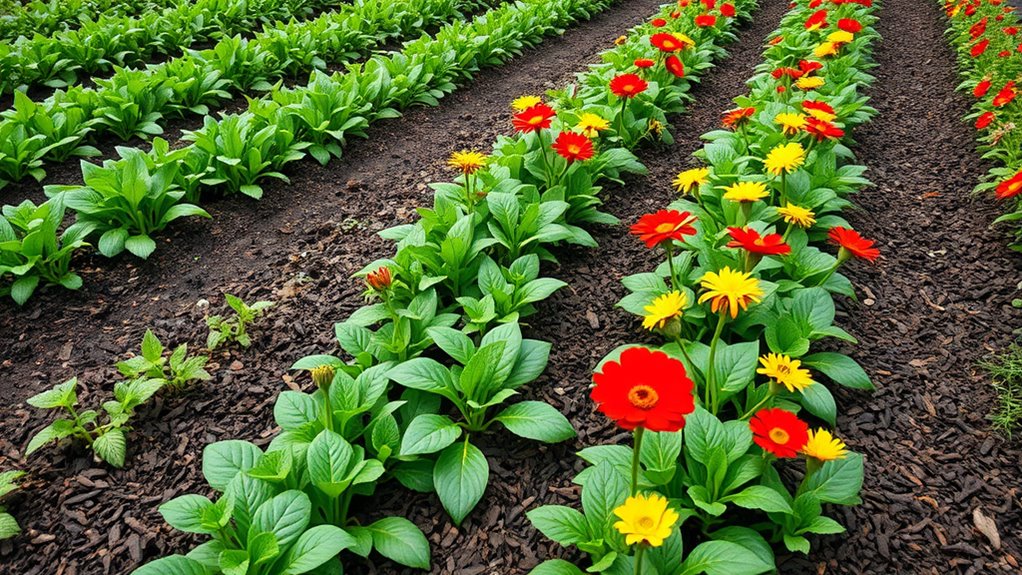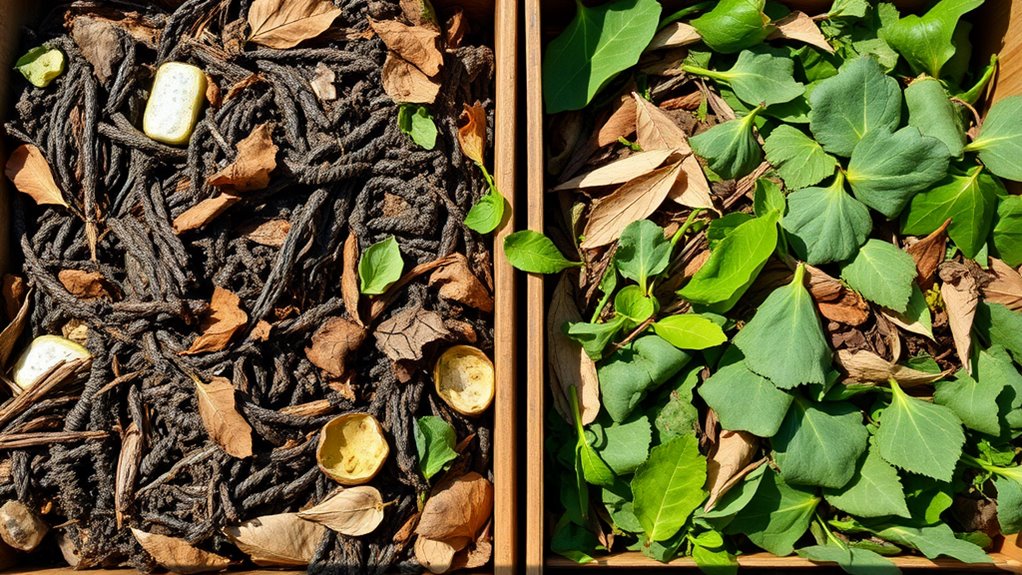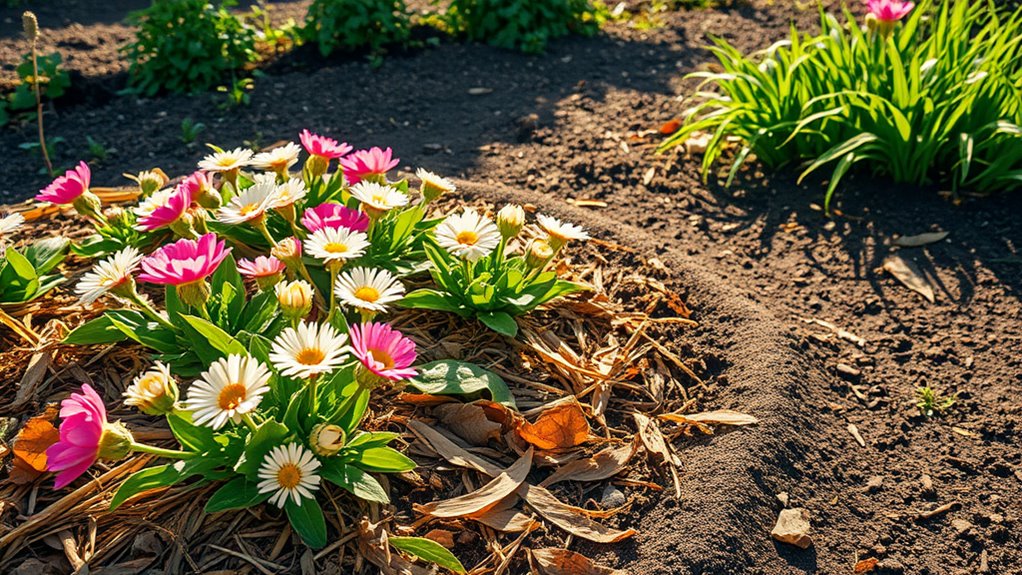My Garden Doubled in Size After This One Mulch Swap
If you’re aiming to double your garden’s size like I did, switch to organic mulch such as wood chips or straw. You’ll retain soil moisture, suppress weeds, and enrich nutrients, leading to healthier plants and significantly higher yields. This simple change promotes explosive growth by improving soil fertility and reducing watering needs. Apply a 2-4 inch layer evenly after preparing your soil, and watch your garden thrive as mine did. Explore mulch types and application tips to unlock even greater potential.
Key Takeaways
- Switching to organic mulch can double garden yields by improving water retention and nutrient supply.
- Organic mulch suppresses weeds and pests, allowing plants to focus energy on growth and expansion.
- Applying mulch at 2-4 inches depth enhances soil fertility, leading to healthier roots and larger harvests.
- Testing different mulch types, like wood chips or straw, helps identify the best option for your garden’s needs.
- Regular mulch maintenance ensures sustained moisture and nutrient benefits, supporting ongoing garden growth.
The Mulch That Transformed My Garden
If you’ve ever battled weeds and soil erosion, you’ll see how organic mulch, like wood chips or straw, can revitalize your garden by retaining moisture, suppressing pests, and enriching the soil over time. By using this mulching technique, you can keep your garden consistently moist throughout the growing season.
Mastering mulching techniques requires selecting materials suited to your landscape; for instance, apply wood chips in pathways for durability and straw in vegetable beds for quick breakdown.
Use proper depth—2 to 4 inches—to avoid stem rot while promoting aeration. Effective techniques include edging to contain mulch and layering for enhanced weed control.
Regularly inspect and refresh to sustain benefits, ensuring long-term soil health through practical application.
Incorporating mulch as described has the potential to turn any garden into a flourishing oasis, fostering a healthier environment for plants.
Why Switching Mulch Made a Difference
You’ve seen how switching mulch enhances your soil’s fertility by adding essential nutrients and improving moisture retention.
This change also boosts your plant growth, leading to healthier, more vibrant foliage and yields.
Now, consider how these benefits directly impact your gardening practices for better results.
Additionally, incorporating fall mulching can prepare your garden for winter by enhancing soil health and shielding plants from harsh weather.
Exploring mulch types can further enhance your garden’s transformation, as they offer varied ways to promote overall plant health and growth.
Enhanced Soil Fertility
Switching to nutrient-rich mulch, like compost or shredded leaves, actively boosts your soil’s fertility by accelerating organic decomposition.
As microorganisms break down the mulch, they release vital nutrients such as nitrogen, phosphorus, and potassium, enhancing your soil’s nutrient profile.
You’ll improve microbial diversity, which fosters efficient organic matter breakdown and increases humus levels for better structure.
This mulch also minimizes nutrient loss through leaching and stabilizes pH, promoting a balanced environment.
Boosted Plant Growth
When you switch to nutrient-rich mulch, it directly accelerates plant growth by delivering sustained nutrients and moisture.
The organic materials break down gradually, releasing nitrogen, phosphorus, and potassium to fuel root development and photosynthesis. You’ll see plants produce more biomass as improved water retention minimizes stress and enhances nutrient uptake, leading to taller stems and fuller canopies.
This mulch also suppresses weeds, allowing your garden to focus energy on growth rather than competition.
For best results, apply 2-4 inches evenly; monitor soil moisture and adjust as needed to maximize yields and achieve noticeable garden expansion.
Exploring Various Mulch Types
As you explore various mulch types for your garden, you’ll encounter options like organic materials (such as wood chips or straw) and inorganic ones (like rubber or plastic).
Organic mulches break down over time, so you choose based on decomposition rate; wood chips suit larger areas for better moisture retention, while straw works for vegetable beds to suppress weeds effectively.
Inorganic mulches, like rubber, offer durability and resist shifting, making them ideal for high-traffic paths; additionally, debunking soil myths can enhance your understanding of how mulch interacts with soil health for optimal gardening results.
Always consider your garden’s climate and maintenance needs—test small patches first to evaluate performance and ease of application.
For even better soil enhancement, consider using backyard solutions with materials readily available in your own yard.
How Mulch Enhances Soil Quality
Mulch boosts soil quality by retaining moisture, suppressing weeds, and regulating temperature, which helps you maintain a healthier garden ecosystem.
As you apply mulch, it minimizes evaporation, keeping your soil consistently moist and reducing watering needs. It blocks sunlight to prevent weed seeds from germinating, saving you time on weeding.
Mulch moderates soil temperature fluctuations, protecting roots from extreme heat or cold, which fosters beneficial microbial activity.
For best results, choose organic mulches like bark or compost; they’re practical, breaking down to add nutrients and improve soil structure over time. Moreover, easy composting tips can help generate nutrient-rich soil that enhances your mulching efforts.
Additionally, incorporating simple ingredient swaps in your compost can lead to even richer mulch that boosts overall soil fertility.
Before and After: Garden Growth Changes
You’ll see your garden’s state before mulch application, where soil might compact and growth lags.
Once you add the mulch, you’ll experience a growth surge that strengthens plant health and vigor.
This results in clear changes in yield, increasing your produce output efficiently.
To maximize these benefits, consider soil testing before applying mulch for even better soil conditions.
For even better outcomes, integrating soil preparation techniques can enhance your garden’s overall health and productivity.
Before Garden State
Before diving into garden growth changes, evaluate your garden’s initial state to identify key factors like soil composition and weed competition, which directly influence plant development. You’ll assess soil pH, nutrient levels, and invasive weeds that stifle roots, hindering your plants’ vitality. Document these to spot patterns.
| Factor | Before State | Emotional Impact |
|---|---|---|
| Soil Quality | Nutrient-poor, compacted | Frustration builds |
| Weed Presence | Overwhelming competition | Discouragement sets in |
| Plant Vigor | Stunted, weak growth | Disappointment lingers |
After Growth Surge
Following a growth surge, you notice marked improvements in your garden’s vitality, where once-stagnant plants now thrive with robust roots and lush foliage.
This shift not only boosts visual appeal but also strengthens the plants’ foundation.
Let’s explore the key changes:
-
Root Deepening: Roots penetrate further into the soil, enhancing nutrient and water uptake for sustained growth.
-
Foliage Thickening: Leaves become denser and greener, improving the plant’s ability to capture sunlight and produce energy.
-
Plant Expansion: Stems grow taller and branches spread wider, resulting in a doubled garden size.
You can measure this growth by comparing before and after photos, noting the significant differences in plant height, width, and density.
Changes in Yield
As your garden’s growth surges, you see a noticeable boost in yield, with pre-surge harvests often limited to sparse quantities that now multiply significantly.
Before the mulch swap, vegetables like tomatoes yielded only a few pounds per plant due to poor soil moisture and nutrient loss.
Now, enhanced water retention and microbial activity double your output—expect carrots to increase from 5 to 10 per square foot, while leafy greens expand from thin patches to lush, harvest-ready beds.
Track these changes by weighing produce weekly; this practical shift optimizes space and reduces watering needs for sustained abundance.
Key Benefits of the New Mulch
The new mulch delivers superior moisture retention, helping you conserve water and keep your garden thriving with less effort.
It’s designed for optimal soil health, reducing evaporation while promoting root growth. This approach aligns with eco-friendly weed control techniques that promote a healthier garden ecosystem.
Beyond that, you’ll enjoy these key advantages:
-
Weed suppression: It blocks sunlight effectively, minimizing weed competition and saving you time on maintenance.
-
Nutrient enrichment: Organic materials break down slowly, releasing essential nutrients that boost plant vigor and yield.
-
Temperature regulation: This mulch insulates soil, protecting roots from extreme weather and ensuring consistent growth.
Additionally, this mulch aids in natural pest control by deterring pests through its organic composition and barrier properties.
Step-by-Step Mulch Application Guide
To apply mulch effectively in your garden, start by selecting the right mulch type based on your soil and plants’ needs.
Next, prepare the application area by clearing debris and weeds for a clean base.
These initial steps ensure your mulch performs at its best and supports healthy growth.
[LIST OF 3 SUBHEADING DISCUSSION POINTS IN ENGLISH
If you’re tackling a garden mulch project, here’s a streamlined guide with three key subheadings: preparing your soil, applying the mulch evenly, and maintaining it long-term.
This practical approach ensures effective results.
-
Preparing your soil: Clear debris, weeds, and rocks first; then aerate and level the surface to improve water infiltration and root health, creating a stable base.
-
Applying the mulch evenly: Measure your area and distribute mulch using a rake for a uniform 2-4 inch depth, ensuring full coverage without smothering plants to promote even moisture retention.
-
Maintaining it long-term: Inspect the mulch bimonthly for thinning or compaction.
Replenish as needed, and fluff it to sustain weed suppression and soil temperature regulation over seasons.
Select Mulch Type
After preparing your soil and applying mulch evenly, choose a mulch type that matches your garden’s specific needs for optimal results. You’ll evaluate factors like moisture retention, weed control, and soil enrichment to pick the best option. For example, organic mulches break down and nourish soil, while inorganic ones last longer.
| Mulch Type | Key Benefit | Ideal Use |
|---|---|---|
| Wood Chips | Retains moisture | Flower beds |
| Straw | Suppresses weeds | Vegetable gardens |
| Gravel | Improves drainage | Pathways |
This selection ensures your garden thrives, enhancing growth and health efficiently.
Prepare Application Area
Before applying mulch, you’ll clear the application area to ensure even coverage and optimal results. This step prevents weeds from competing with your plants and maintains soil health.
Focus on these key actions:
-
Remove debris: Clear leaves, rocks, and old plant material using a rake or garden tool to create a smooth surface.
-
Weed thoroughly: Pull out weeds by the roots and apply a natural herbicide if needed, avoiding chemical residues.
-
Level the soil: Use a hoe or leveler to even out bumps and depressions, promoting uniform mulch depth for better moisture retention and root protection.
Selecting the Ideal Mulch for Plants
When you choose mulch for your garden, focus on factors like plant type, soil conditions, and climate to ensure optimal growth and health.
For instance, select organic mulches like bark or compost for acid-loving plants, as they break down and enrich soil nutrients.
In clay-heavy soils, choose coarse materials such as wood chips to improve drainage and aeration.
In hot climates, opt for light-colored mulches that reflect sunlight and reduce soil temperature, preventing root stress.
Always test your soil’s pH first; it guides you toward mulches that won’t alter it adversely, promoting robust plant development.
Mulch’s Role in Weed Control and Moisture
Mulch plays a key role in suppressing weeds and conserving soil moisture, building on your mulch choices to enhance garden efficiency. By blocking sunlight, it prevents weed seeds from germinating, while its layer traps water to reduce evaporation.
To maximize these benefits, follow these steps:
-
Apply a 2-4 inch layer**** evenly around plants, ensuring it doesn’t touch stems to avoid rot and effectively smother weeds.
-
Choose organic mulches**** like bark or straw, which break down to improve soil structure and retain moisture longer than synthetics.
-
Monitor and replenish mulch seasonally, checking for compaction or thinning to maintain weed control and optimal hydration levels.
This approach keeps your garden thriving efficiently.
Sustaining Garden Health With Mulch
Effective mulch application sustains your garden’s health by enriching soil nutrients and fostering beneficial microorganisms.
You’ll enhance fertility as organic mulch decomposes, releasing nitrogen and phosphorus while improving soil structure for better aeration. It regulates moisture and temperature, shielding roots from extremes and reducing erosion.
Choose materials like compost or wood chips based on your soil type; apply 2-4 inches evenly, avoiding plant stems to prevent rot.
Monitor regularly, turning mulch to promote decomposition and deter pests. This practical approach ensures long-term vitality, boosting plant resilience and yields effortlessly.





